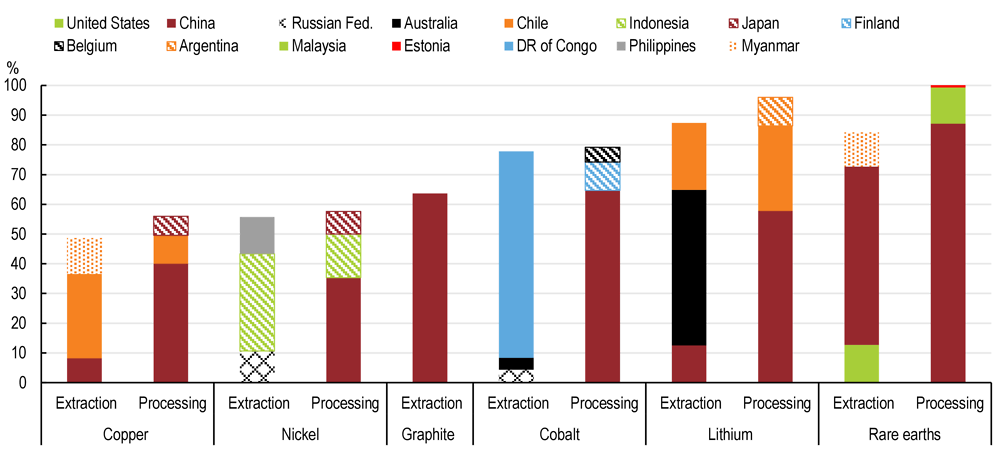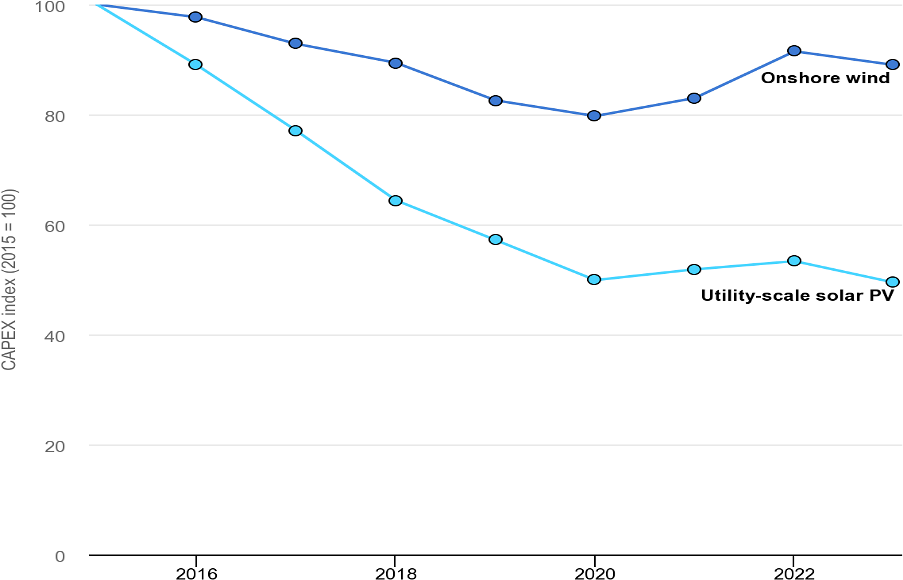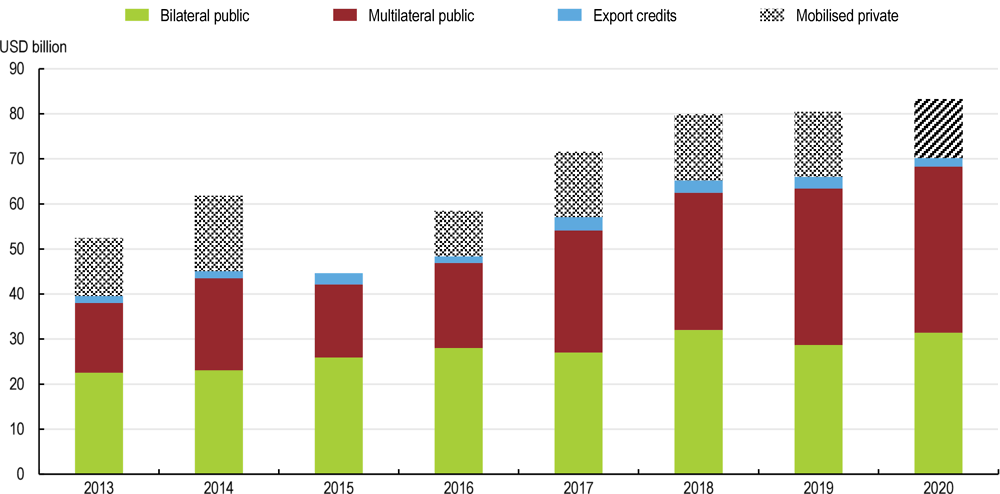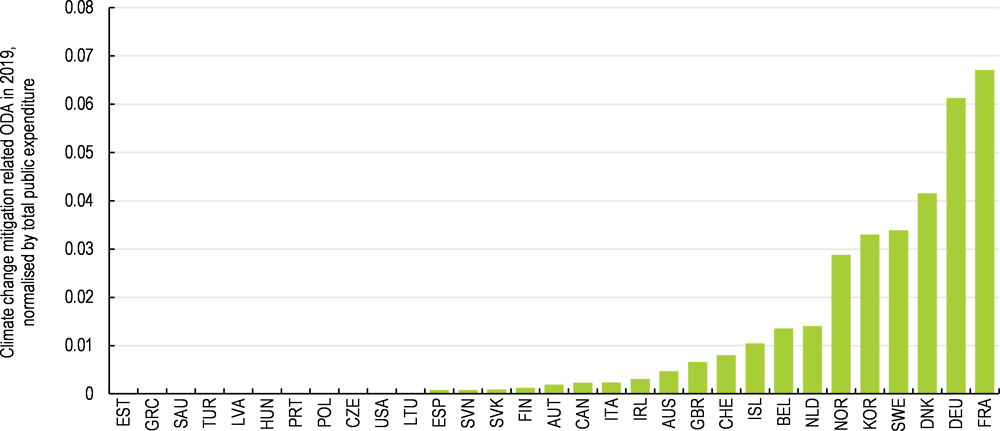Advancing with the net-zero challenge requires dealing with the barriers or constraints to implementing decarbonisation policies, as well as ensuring that no one is left behind. These factors will determine the range of policies that can be implemented and their effectiveness in reducing GHG emissions. A tailored policy mix implies considering the critical materials associated with policy responses and considering the possible headwinds and tailwinds from the broader policy landscape.
The Climate Action Monitor 2022
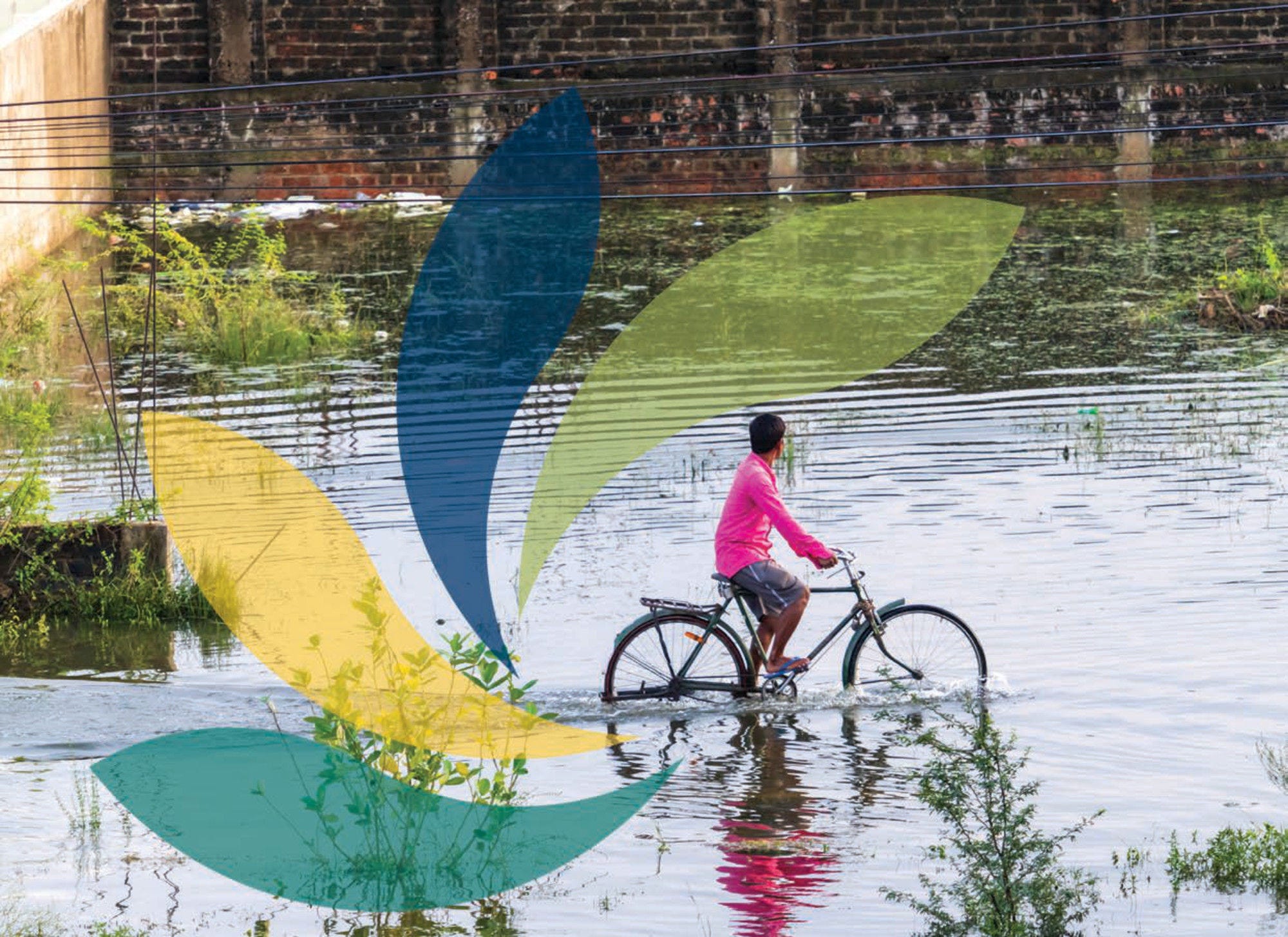
4. Barriers and opportunities for the net-zero challenge and a just transition
Barriers
Critical materials
The transition to net zero requires the use of critical materials. Green technologies, such as batteries, electric vehicles, PV panels or wind turbines, require more material than their fossil-fuel equivalents. This particularly includes copper and aluminium for electric systems, or lithium, cobalt and graphite for batteries. Rare earths are crucial for wind turbines, electric and hybrid vehicles, cellular telephones, computer hard drives, flat-screen monitors and televisions. For instance, according to the IEA, an average electric car requires six times the mineral inputs of a conventional car (see Figure 34), and an onshore wind plant requires nine times more mineral resources than a gas-fired plant (IEA, 2021[83]).
Considering the current technology, achieving the Paris Agreement goals would require that the material used for green technology be multiplied by four by 2040, a trend far above the current development pace of these markets (current resources and mining projects will only allow for the doubling of production) (IEA, 2021[83]). Bottleneck risks are looming in the short- and medium- terms, and tensions are already beginning to show. Material prices are increasing (the price of lithium increased sevenfold between early 2021 and May 2022), and lithium shortages prompted interruptions of the production chain in some manufacturers (The Economist, 2022[84]). Markets are expected to get even tighter in the next decade as developing new mining sources takes time (an average of 16.5 years between discovery to first production) (IEA, 2021[83]), and countries are rapidly increasing their climate ambitions, including with the development of electric vehicles.
Figure 34. Technologies supporting decarbonisation require additional material
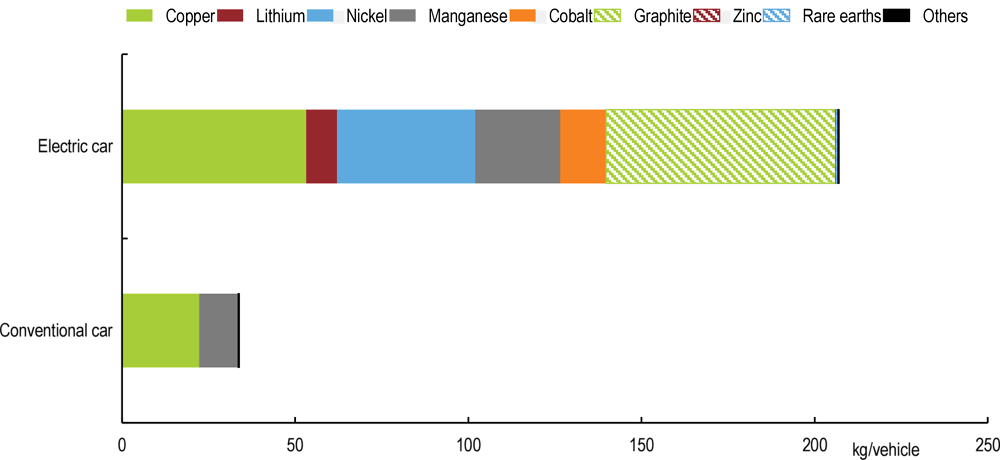
Source: IEA, Minerals used in electric cars compared to conventional cars, IEA, Paris (IEA, 2021[85])
Dependence on these materials puts a new risk on the global energy system. The extraction of these critical materials is concentrated in a very small number of countries. For example, three countries produce 77% of lithium, and one accounts for 65% of graphite production (IEA, 2021[83]) (see Figure 35). Concentration gets even stronger in the processing phase, where China is predominant. This makes the supply chain particularly vulnerable to unilateral shocks, with possible bottlenecks and soaring prices that would hamper the transition. Indeed, raw materials make up a significant share of green technology costs (e.g. 50-70% of total battery costs), and tight material markets could prevent the large take-up of these technologies.
Figure 35. Extraction and processing of critical materials are very concentrated in some countries
Climate plans and announcements must therefore factor in the risks related to critical materials and, most importantly, strive to alleviate these risks so that they do not hamper the climate transition. Implementing a credible and stable pathway to net zero calls for the development of new sources throughout the world, new processing manufactures and accelerated investments. In parallel, dependence of the transition on extracted materials can be reduced with new technologies and the development of recycling chains for these specific materials.
The broader policy landscape
Tailwinds
Tailwinds refers to a broad range of events outside the climate change policy space, such as changing economic or social conditions, discoveries, and/or innovations, that can support and facilitate the transition to net-zero. For example, between 2015 and 2020, the costs estimate for solar PV and onshore wind investment for new contracted projects fell by 50% and 20% respectively (see Figure 36). Countries should consider market trends, such as these, in the development of their net-zero strategies (IEA, 2022[86]).
Investment in renewable energy has been driven by innovation and strong public support (e.g. public investment or feed-in tariffs). However, increasing efficiency gains are driven by learning-by-doing and additional investment from the private sector. As a result, a large part of renewable energy is now equal to or even more profitable than energy based on fossil fuels in many countries, attracting new private investments and research and nurturing a virtuous circle between innovation and production (see Box 6). Increased private investment and research would allow for a phasing down of public support, particularly feed-in tariffs, which have already been reduced or cut in some countries. Between 2000 and 2020, energy production from renewable sources has grown by 63% globally and by 82% among OECD countries (IEA, 2022[87])
Figure 36. Solar PV and onshore wind investment cost estimates for new contracted projects
Box 6. The renewable energy boom in Denmark
In Denmark, support for renewable energy generation through a complementary combination of R&D funding, streamlined planning processes, subsidies and national targets has driven down costs through learning-by-doing and economies of scale. This is particularly the case in offshore wind, where it took decades of sustained support to bring down high installation costs. Key initiatives to incentivise deployment included, first, feed-in tariffs, complemented by the introduction of a carbon tax in 1992, then an environmental premium added to the market price and, finally, tenders for new renewable capacity.
This approach has seen risk gradually shift from the government and electricity consumers to investors. A range of renewable technologies is now competitive with fossil-fuel generation, particularly after taking into account a mid-range estimate of the cost of carbon consistent with the Paris Agreement. While sunk capital reduces the economic cost of existing plants, renewable energy facilities are still set to be installed without subsidies in the decade ahead. Denmark’s lead in wind energy has contributed to the development of a sophisticated export industry. The manufacture of wind turbines embodies a continuous accumulation of sophisticated knowledge, with the technological advantage of a few leading companies growing over time.
Source: OECD (2021[88]).
Headwinds
Headwinds refer to a range of events outside the climate change policy sphere, such as changing political conditions, discoveries, economic crises or conflict that can hamper or even undermine the climate transition. The war in Ukraine has increased uncertainty, restricted supply lines, reduced grain production, and above all affected energy markets, already under pressure due to the post-COVID crisis. The European gas market has been particularly affected, and potential shortages might call for, at least the temporary, reversal of European countries’ decarbonisation plans, particularly related to the access to natural gas considered as a transitional fuel while countries increase renewable energy sources
Reduced access to natural gas has prompted the reopening of coalmines, and there is a risk that decarbonisation pathways are compromised. Therefore, policy must address the challenge of climate change while managing the energy crisis. Developing stable energy systems with diverse and complementary renewable sources and bringing storage solutions to maturity are all the more urgent.
The United States provides an example of dealing with the energy crisis and supporting decarbonisation. The recent Inflation Reduction Act (2022) simultaneously deals with increased energy costs and promotes low-carbon investment. The bill introduces tax credits for clean sources of electricity and energy storage, and roughly USD 30 billion in targeted grant and loan programmes for states and electric utilities to accelerate the transition to clean electricity, as well as clean fuels and commercial vehicles (see Box 7).
Box 7. The US Inflation Reduction Act
On 12 August 2022, the US House of Representatives passed the Inflation Reduction Act, a major climate and tax bill. The bill includes measures to improve energy security and address climate change. Revenue will be raised by introducing a minimum corporate tax rate of 15%, a new tax on share buybacks, improved tax enforcement by the Internal Revenue Service and prescription drug price reform.
According to the Congressional Budget Office, this legislation is expected to result in a net decrease in the deficit, totalling USD 102 billion over the 2022‑31 period. The enhanced health insurance subsidies and energy-related subsidies will be the largest spending items, while the minimum tax on corporations will be the largest contributor to reductions in the deficit.
The Rhodium Group, an independent climate research centre, estimated that the Inflation Reduction Act could cut US net greenhouse gas emissions to 31‑44% below 2005 levels in 2030 – with a central estimate of 40% below 2005 levels – compared to 24‑35% under current policy (King, Larsen and Kolus, 2022[89]).
Specific measures include:
Lowering consumer energy costs through consumer home energy rebate programmes consumer tax credits for energy-efficient and clean energy in homes, and clean vehicles.
Improving energy security and domestic manufacturing with production tax credits to accelerate US manufacturing and investment in clean technology manufacturing facilities.
Decarbonising the economy with tax credits for clean sources of electricity and energy storage and clean vehicles, as well as a Methane Emissions Reduction Program to reduce the leaks from the production and distribution of natural gas.
USD 10 billion to invest in community-led projects to ensure environmental justice.
Over USD 25 billion in grants and loans to support climate-smart agriculture practices, and forest conservation and urban tree planting in agriculture and rural communities.
Source: US Government (2022[90]).
Ensuring a just transition
Costs and opportunities from the transition
Public acceptance of climate action is crucial for the design and implementation of effective and feasible climate policies. There is ample evidence that public opinion constrains (Burstein, 2003[91]) and directs the actions of decision-makers (Erikson, Mackuen and Stimson, 2002[92]). Public opinion may be especially relevant in the case of climate change mitigation, with many studies arguing that the introduction of effective policies to curb climate change is constrained by the lack of public support. For example, Harrison (Harrison K., 2010[93]) demonstrates how Canadian climate opinion has affected federal policy choices. (Crowley Kate, 2017[94]) suggests that the Australian repeal of its carbon tax in 2014 was at least partly due to public opposition. The cases of France1 and Ecuador2 provide clear examples that public opinion and opposition were critical in changing carbon-pricing policies.
International comparisons show that perceptions of distributional fairness and personal losses and gains can play a significant role in public acceptability around climate action. Clear communication on the effectiveness of policies is also crucial (Dechezleprêtre et al., 2022[68]). Integrating environmental costs and social inclusiveness aspects into recovery packages and measures for the net-zero transition may be a way forward (Kallbekken and Saelen, 2011[95]). In the case of carbon-pricing policies, using revenues to compensate vulnerable groups or ease the transition of carbon-intensive firms that lose competitiveness may also be a viable strategy (UN, 2021[96]).
Therefore, enhancing public acceptability requires, on the one hand, protecting vulnerable groups from socio-economic impacts associated with the net-zero transition and, on the other, ensuring the creation of new opportunities. Providing thorough information to households and firms on how policies will contribute to climate change mitigation and deliver the expected outcomes is also crucial, particularly if sacrifices are projected.
In the first case, the design of accompanying and compensating policy measures may be key. A first step for policymakers is to ensure that alternatives to fossil fuels and emission-intensive goods and services are available. For instance, developing clean public transport and supporting the procurement of electric vehicles or heat pumps will allow households to reduce their emissions without much deprivation. In the short term, when these alternatives are not available, compensating measures, notably social protection, can be used to avoid the deterioration of households’ well-being.
The transition to a green economy could profoundly impact individuals and communities. A power station or a manufacturing plant closure can shape family circumstances and livelihoods. Social protection will be a crucial building block of governments’ strategies to promote a just green transition by preventing and cushioning individuals and communities from potentially damaging disruptions to their livelihoods, thus easing voter resistance to carbon pricing and other mitigation efforts. The co-ordination of migration and housing policies should also be anticipated.
While modest overall, the estimated employment impacts of decarbonisation will be much higher in some regions. On average across OECD regions, only 2.3% of employment is in sectors at potential risk from climate policies consistent with the Paris Agreement. However, in some large regions, this may exceed 6%. For example, in the Polish region of Silesia, more than half of employment is in at-risk sectors (in the mining of coal and lignite), and one-quarter is in the manufacturing of rubber and plastics products (IEA, 2021[97]).
Employment opportunities may not materialise where losses occur, which is why vulnerable regions and communities will need targeted support. Countries are considering implementing mechanisms to support communities in this transition, including with new dedicated institutional frameworks. Spain has developed such a framework to ensure dialogue and participation with relevant stakeholders, an interesting model countries may wish to explore.3
In the second case, new investment and economic opportunities may reduce the risk of resistance. Recent estimates suggest that new investments in the energy sector alone are USD 1 trillion by 2050 for production of wind turbines, solar panels, lithium-ion batteries, electrolysers and fuel cells (IEA, 2021[97]). Moreover, a recent study by the International Monetary Fund points out that the multipliers of aggregate demand for investments associated with activities linked to the green economy are considerably higher than traditional investments, by two to seven times, suggesting these investments will generate new employment opportunities (Batini et al., 2021[98]).
Therefore, countries will need to seize the opportunities of the transition to alleviate the costs. New “green” skills can help local economies secure employment for workers who lose jobs in the transition. By way of balance, it is estimated that some 24 million jobs worldwide could be created by the green economy by 2030 (United Nations, 2019[22]). Ensuring that workers have the necessary green skills is thus essential.
The transition to a green activity is easier among high-skilled workers, however (IMF, 2022[99]). This highlights the key role of labour market and skills policies in countries’ capacities to manage and profit from the green transition. Greening of skills is likely to require upskilling, as low-carbon sectors are estimated to require more skills than carbon-intensive industries. In addition, on-the-job training should be given priority over external retraining programmes to ensure a connection to job prospects. Skills mapping can also help identify skill needs in future investment priority areas. This is particularly important in regions in industrial transition, where it is often uncertain how workers’ skills in “brown” industries are transferable to emerging jobs in low-carbon sectors (OECD, 2021[100]).
The above discussion suggests that green recovery packages that combine local development with the energy transition may be a way forward.. Governments’ responses to the COVID-19 pandemic initially focused on containing the virus and limiting damage to the economy. As vaccines were progressively rolled out, governments drew up ambitious recovery plans to restart their economies. Furthermore, several governments issued pledges to “build back better” and adopted net-zero targets by mid-century (UN, 2021[101]). However, faced with the energy crisis, countries have been slow to implement.
Since 2021, there has been a significant increase in green recovery measures in OECD countries, the European Union and selected non-OECD large economies (OECD, 2021[102]). The estimated budget allocated to environmentally positive measures is USD 1 090 billion. This amounts to around 33% of total recovery spending announced since the pandemic's start (up from 21%). Korea, Germany and Spain lead in total green spending. Under the lens of green spending as a proportion of GDP, Korea, Spain and the United Kingdom take the lead. Despite these countries' efforts, other countries' recovery measures lacked a green focus in 2020 (O’Callaghan and Murdock, 2021[103]).
Furthermore, budgets allocated to measures with mixed and negative environmental impacts have also slightly increased, to USD 290 billion and USD 178 billion, respectively. More than half of identified green spending (or USD 611 billion) is directed towards the energy and transport sectors, which are central to net-zero and energy security strategies. Within the transport sector, countries increasingly shifted investments from road to rail infrastructure, but more spending for sustainable transport modes is needed to achieve the goals of the Paris Agreement.
A well-being lens
Although “build-back better” has been limited, countries should continue to explore integrated approaches. Recognising that climate action can contribute to a broader reform agenda for greener, more resilient and inclusive growth, countries can explore coupling climate action with wider well-being objectives considering better designed tax codes, pro-growth long-term infrastructure investment, and energy and transport systems that support cleaner air, better health and a more diversified energy supply.
The OECD has developed a process – the Well-Being Lens – to support countries to identify and prioritise policies leading to transformational pathways which are essential to move towards net-zero. The process has three steps: 1) envision the outcomes a well-functioning system achieves; 2) understand why the current systems’ functioning is not achieving such outcomes and how the system could be reorganised to lead to better results by design; and 3) identify the actions and policies with the potential to change the systems’ functioning towards a better one. See Box 8.
Box 8. The Well-Being Lens in the Transport Sector
The Well-Being Lens approach has been applied to the surface transport sector, which has led to the following results:
Envision: A well-functioning transport system fosters the sustainable delivery of accessibility, i.e. the possibility to access places with ease by creating proximity to places and privileging healthy, safe and sustainable transport modes (e.g. walking, cycling, public transport).
Understand: A conflation between mobility and well-being has led to transport policies fostering physical movement (mobility). However, more mobility does not equal more well-being; high traffic volumes are thus not a inevitably, nor the result of people’s independent preferences, as often claimed. High traffic volumes are the result of transport and urban systems organised around car driving, which leads to the dynamics of induced demand, urban sprawl, and the erosion of shared and active modes of transport. The key problem is thus no longer vehicles’ emission performance but the systems’ dynamics leading to an increase in the number of vehicles.
Change: For climate strategies to accelerate the transition towards net-zero systems, priority is given to policies reversing the three dynamics mentioned above.
Policies with the potential to change the systems’ functioning and accelerate the transition towards net-zero transport systems by design include:
Street redesign and improved management of public space.
Spatial planning aimed at redesigning territories to increase proximity.
Multi-modal and sustainable transport networks.
Changes at the level of governance and monitoring frameworks, as well as systems innovation.
Source: OECD, 2022.
Supporting the transition in developing countries
At the Fifteenth meeting of the Conference of the Parties (COP 15) in Copenhagen in 2009, developed countries committed to provide and mobilise, by 2020, USD 100 billion a year for less wealthy nations to help them mitigate and adapt to climate change. To date, the total amount of climate finance provided and mobilised has reached USD 83.3 billion. The collective level of developed country climate finance was short of the goal by USD 16.7 billion. Nevertheless, financial resources provided have been steadily increasing. For example, total finance achieved in 2020 increased 4% from 2019, under the extraordinarily difficult conditions imposed by the COVID-19 crisis; this represents an increase of 42% since 2016 (OECD, 2022[104]) (see Figure 37).
Mitigation remains the principal area in which finance is directed, representing 58% (USD 48.6 billion) of total finance in 2020. It fell, however, 5% while adaptation finance increased by 40%, reaching USD 28.6 billion and representing 34% of total funds mobilised, the highest percentage registered to date. The sectoral distribution remains concentrated in energy projects, transport and agriculture.
Figure 37. International climate finance mobilised reached USD 83.3 billion in 2020
Mobilising additional private capital will be important as developing countries move to finance their energy transition. Official development assistance (ODA) from official donors rose to an all-time high of USD 178.9 billion in 2021. This represents an increase of 4.4% in real terms from 2020, triggered by support over the COVID‑19 crisis. In 2019, about 27% of ODA targeted climate action. Furthermore, in 2019, members of the OECD Development Assistance Committee (DAC) committed USD 34.3 billion in bilateral allocable ODA that principally or significantly targeted climate action (screened against the Rio markers). This represents an increase in volume of 45% since 2014. Some 43% went to climate change mitigation activities, 33% to climate change adaptation and 24% to projects that addressed both climate change mitigation and adaptation (Figure 38) (OECD, 2022[106]).
The international community must give particular attention to extractive-based countries. The carbon footprint of oil and gas projects will affect prospects for continuous market access and has global equity implications, considering the weighted value of income in countries with a diversified industrial base compared to fossil-fuel-dependent developing economies, where diversification is challenging. Thus, these countries will need support to manage uncertainties and increased vulnerability, to build their resilience to external shocks, and embrace the challenge of undergoing unprecedented economic and social transformation (OECD, 2021[107]).
International trade, coupled with appropriate environmental and societal policies, can be a principal driver of the transition to an inclusive green economy. To achieve ambitious environmental outcomes, countries are expected to raise the level of stringency of their environmental policies; citizens are expected to demand more goods and services that are “environmentally friendly”; and businesses are expected to seek cleaner investment opportunities. This, in turn, can generate higher demand for products deemed “environmental” – which “measure, prevent, limit, minimise or correct environmental damage to water, air and soil, as well as problems related to waste, noise and eco-systems” (OECD/Eurostat, 1999[108]) – as firms and households seek to alleviate the compliance costs of new environmental regulations and access environmental goods and services.
Figure 38. Expenditure for climate change mitigation-related ODA differs between countries
Policies are developed under countries owns circumstances including their broader economic and institutional frameworks. These include both the opportunities and challenges that countries may face. Therefore, the effectiveness of climate policy choices will not only depend on effective design, but also on how countries consider and take advantage of this broader policy context, or tailwinds and headwinds, that interact with climate action.
Tailwinds are policies or trends that can enhance the performance or effectiveness of climate action. Headwinds are policies or trends that work in opposition to the direction of climate action efforts. Policy makers must be cognizant of these policies and trends to ensure that climate action is effective. However, in the long-term, climate action will only be viable, feasible even, if it is consistent with broader development and well-being objectives. Only by making decarbonisation an integral part of the global development effort where no one, across or within countries, is left behind, will it be possible to ensure a sustainable, inclusive, and resilient national and global development path.
Notes
← 1. In November 2018, there were public protests by the “Yellow Vest” movement against the planned doubling of a carbon tax — from 44.6 to 86.2e/tCO2 in 2022.
← 2. A wave of protests and demonstrations began in Ecuador in October 2019 following the announcement of a series of economic measures, including the elimination of subsidies and price control on diesel and gasoline. Ecuador has one of the lowest gasoline prices in the world and these policies have implied millions in direct subsidies, generating what in practice has been a negative carbon price.
← 3. https://www.transicionjusta.gob.es.
